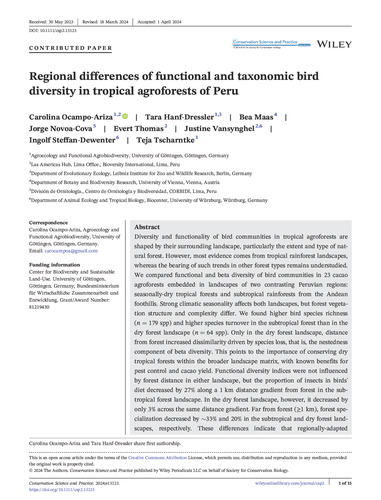Regional differences of functional and taxonomic bird diversity in tropical agroforests of Peru
Diversity and functionality of bird communities in tropical agroforests are shaped by their surrounding landscape, particularly the extent and type of natural forest. However, most evidence comes from tropical rainforest landscapes, whereas the bearing of such trends in other forest types remains understudied. We compared functional and beta diversity of bird communities in 23 cacao agroforests embedded in landscapes of two contrasting Peruvian regions: seasonally-dry tropical forests and subtropical rainforests from the Andean foothills. Strong climatic seasonality affects both landscapes, but forest vegetation structure and complexity differ. We found higher bird species richness (n = 179 spp) and higher species turnover in the subtropical forest than in the dry forest landscape (n = 64 spp). Only in the dry forest landscape, distance from forest increased dissimilarity driven by species loss, that is, the nestedness component of beta diversity. This points to the importance of conserving dry tropical forests within the broader landscape matrix, with known benefits for pest control and cacao yield. Functional diversity indices were not influenced by forest distance in either landscape, but the proportion of insects in birds' diet decreased by 27% along a 1 km distance gradient from forest in the subtropical forest landscape. In the dry forest landscape, however, it decreased by only 3% across the same distance gradient. Far from forest (≥1 km), forest specialization decreased by ~33% and 20% in the subtropical and dry forest landscapes, respectively. These differences indicate that regionally-adapted agroforest management is paramount for conserving bird diversity and ecosystem services as pest control. Procuring high-canopy shade trees and adequate microhabitats for insectivorous species is essential to maintain biocontrol services in the subtropical forest. Conversely, in the dry forest enhancing low-canopy vegetation with a focus on frugivores and ensuring forest closeness to agroforests may maximize bird diversity and their ecosystem services. A complete version of this article is translated to Spanish in the supplements.

